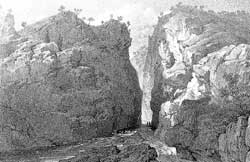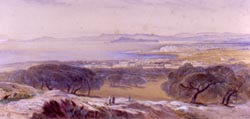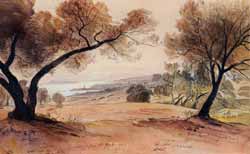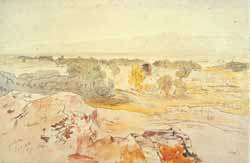Impact of Ottomans on Crete
 The ‘Iron Gates’ near the mouth of the Samaria Gorge. © Hakkert |
The next major English writer was Robert Pashley, whose travels in 1834 we have met earlier in Unit 1 Session 4 Lesson 4. Building on the foundations laid by Pococke, he wrote what remains perhaps the best book on the island. He took a greater interest than Pococke in the customs and beliefs of the contemporary Cretans, he conducted his own census of each village on the island, and also made great progress in the study of the antiquities.
The interest in Greek antiquities had already reached new heights in mainland Greece (especially Athens) from the mid-eighteenth century onwards; we have already seen the work of Dodwell (Unit 1 Session 5 Lesson 2).
During the rest of the nineteenth century an increasing number of travellers, of diverse backgrounds, continued to work on the island. The French geographer Victor Raulin travelled on the island in 1845, publishing first as articles and then as a pair of volumes his Déscription physique de l'ile de Crète (Paris, 1869). One volume is the first systematic geological study of the island, the other a systematic account of the economic and social conditions of the island (based in part on a detailed publication by the French consul in Khania).
From a quite different background, but also with the assistance of the relevant authorities, Captain T. A. B. Spratt published his Travels and Researches in Crete (1865). This was based on work done in 1854 when he was appointed director of the Mediterranean Survey for the British Navy. He produced the first proper nautical charts for Crete, and also the first edition of The Mediterranean Pilot, a work still in print (in its 11th edition, 2000). He and Raulin were the first to note the major uplift of the western end of the island, arguing correctly that it occurred in the late Roman period (we noted in Unit 1 Session 2 Lesson 3 the use of radiocarbon evidence in offering a more precise dating for this event). He also studied the antiquities of Crete: the remains of Gortyn, for example, were described at some length, as were the theatre, the church of Saint Titus (drawing on the work by Belli that had recently been published) and the amphitheatre.
 Khania: harbour, by Edward Lear (26 May 1864). © Denise Harvey |
Crete was also visited by artists, whose images have been influential in forming our modern vision of the island.
 Khania: painting by Edward Lear, based on a drawing made on 15 April 1864. Courtesy of the Ashmolean Museum, University of Oxford. |
The most notable of these was Edward Lear. Lear is best known today as the author and illustrator of nonsense poems, but his real love was painting.
 Khania: painting by Edward Lear. © Denise Harvey |
He published some illustrated travel books, and in 1864 visited Crete to gather material for another book (which sadly did not come to fruition).
 A view of Gortyn, as painted by Edward Lear, 17 May 1864. © Denise Harvey |
He was an energetic traveller, who produced 200 sketches in Crete, which are some of the most luminous images of the island ever created.